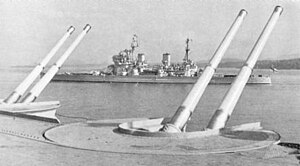QF 4.5 inch Mk I - V naval gun
| Ordnance QF 4.5 inch gun Mk I, II, III, IV, V | |
|---|---|

Mk III guns in BD 'RP10' Mk II mountings on Implacable-class aircraft carrier
|
|
| Type |
Naval gun Anti-aircraft gun |
| Place of origin | United Kingdom |
| Service history | |
| Used by | British Commonwealth |
| Wars |
Second World War Korean War Falklands War |
| Production history | |
| No. built | Navy: c. 800 Army: 474 |
| Specifications | |
| Barrel length | Bore: 16 ft 8 in (5.08 m) 45 calibres |
|
|
|
| Shell | Fixed or Separate QF 55 pounds (24.9 kg) |
| Calibre | 4.45-inch (113 mm) |
| Breech | Mks I - IV: Horizontal sliding block Mk V: Vertical sliding block |
| Rate of fire | 12 RPM for Mk II BD mount. 16 RPM recorded for Mk III UD mount. |
| Muzzle velocity | 2,449 ft/s (746 m/s) |
| Maximum firing range | 20,750 yd (18,970 m) at 2,449 ft/s (746 m/s) AA:41,000 ft (12,500 m) |
The QF 4.5 inch gun has been the standard medium-calibre naval gun used by the Royal Navy as a medium-range weapon capable of use against surface, aircraft and shore bombardment targets since 1938. This article covers the early 45-calibre family of guns up to the 1970s. For the later unrelated 55-calibre Royal Navy gun, see 4.5 inch Mark 8 naval gun.
Like all British nominally 4.5 inch naval guns, the QF Mk I has an actual calibre of 4.45 inches (113 mm).
From the BL Mark I gun of 1916 onwards the 4.7-inch (120-mm) calibre was the mid-calibre weapon of choice for the Royal Navy, used particularly on destroyers. Apart from some ships armed with QF 4-inch Mk V guns due to supply problems, it remained the standard weapon for destroyers up to the W-class destroyers of 1943. However, its usefulness as an anti-aircraft weapon had been limited by the failure to develop a mounting with elevation over 55°, the lack of a predictive fire control system in destroyer classes built prior to the introduction of the 4.7 inch twin mount (see HACS), and the setting of fuzes by hand on early, prewar, mountings. Later 4.7 inch mountings used mechanical fuze setters that were identical to those used on the 4.5 inch mountings.
The QF 4.5 inch L/45 was developed originally as a dual-purpose weapon with which to arm aircraft carriers and reconstructed battleships and battlecruisers. It was later developed as a new dual-purpose weapon with which to arm destroyers, supplanting the ubiquitous 4.7 inch gun. Despite the lower calibre, it actually had a heavier shell, resulting in a more powerful weapon.
The nomenclature system for guns used by the Royal Navy can be somewhat confusing. The gun and mounting each have their own Mark number and a letter(s) giving additional information. QF stands for "quick firing", UD for "upper deck", BD for "between decks" and CP for "central pivot".
...
Wikipedia
